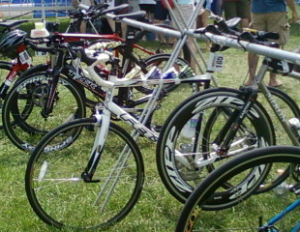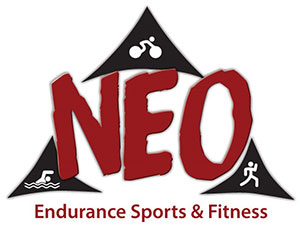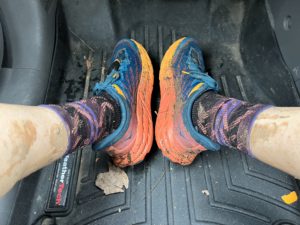
What the heck do you eat when racing? That’s a really good question and most everyone will have a different answer. As I mentioned last week, you need to figure out what works for you.
Let’s go through some of the options that are out there. But remember, just because a pro or big name uses it, doesn’t mean it will work for you. And as with any food, read the label first to make sure you are OK with what is in it.
(A quick note here: while I will just mention food nutrition in this post, other supplements are not regulated by the Food and Drug Administration and therefore not subject to the same rules, ie labeling requirements. It’s how some athletes have gotten into trouble with banned substances. For more information on supplements, got to the USADA’s Supplement 411 site.)
We use “sports nutrition” because when we do endurance events, we typically need to use some sort of caloric supplement (some form of carbohydrate, usually a kind of sugar) because we burn through our stored muscle glycogen. In order to keep moving, we need to provide our body with an energy source.
Below are different kinds of products, when they are used, and I will also share a bit of my experience with them.
1) Sports drinks. These are fluid-based calories and often have electrolytes added in as well. The original was gatorade, and now there are tons of options on the market. Gatorade, Accelerade, PowerBar endurance, HEED and also new to the market Skratch Labs Hydration Mix, just to name a few.
These are made with different kinds of sugars (glucose, fructose, sucrose, maltodextrin) so if you go the sports drink route, pay attention to the type of sugar and what might work best for you. Sports drinks often also have electrolytes, so you’ll want to look at that profile as well. For example, HEED uses maltodextrin and has lower electrolyte profile than most others. Sports drinks are usually good for shorter events (ie 10k or sprint triathlon) because you don’t really need many calories, perhaps just a kick at the end.
2) Liquid Calories. I’m separating these out because they are “thicker” than most traditional sports drinks as they are meant for calories, while sports drinks were initially meant to aid in hydration. In this category would be products like Hammer Nutrition Sustained Energy and Perpetuem. Some of these have a little bit of protein and will have an electrolyte and possibly an amino acid profile as well.
Another non-traditional sports drink I’d like to mention is Generation UCAN. It’s a corn-starch based product (sounds odd, and the consistency is different from your traditional drink) but because it based off a very large molecular weight polymer, it gets absorbed quickly through your stomach and also keeps your blood sugar a lot more stable than from consuming pure sugar sports drinks. I’ve used this as my pre-race fuel for short events and also during long events such as half and full-ironman races.
If you aren’t able to tolerate solid foods during your event, these can be good choices.
3) The Gel. This is a semi-solid form of calories. Most of these are just sugar, although a few brands have added amino acids, and sometimes caffeine as well. As with the sports drinks, different brands will use different sugar combinations. Different brands also have different textures, and some do better across different temperature ranges. (Nothing like “chewing” a gel on a cold run.)
I usually opt for Hammer Gels because I like the flavor (espresso, vanilla, or chocolate). I use gels at the end of races during the run, say at the half-way point of the 10k in an olympic distance race, or about every 40 minutes in a half-ironman run. But once I had some samples of Pacific Health Labs 2nd Surge gels with 100mg of caffeine. Let me tell you, this was an awesome boost just before a short 20 minute crit and also for a 3.1 mile TT with about 1300 feet of elevation gain! As with anything new, I made sure to test it before race day!
4) The Bar. Solid food is often good for longer events, when your intensity isn’t too high and you want to keep your stomach from growling. They are also not “pure sugar” like gels and sports drinks so they are slower to digest. Go to any grocery store and you will be overwhelmed with the amount of sports bars out there. Read the labels, as the more “natural” the bar, the better it will be for you. Look at the protein and fiber content in the bar, as too much protein during an endurance event might be tough to digest.
My go-to bar has always been the Clif Bar (peanut toffee buzz was my flavor of choice for Ironman Arizona) but I recently got turned on to Breeze Bars (gluten & dairy free option) that have the same number of calories as a Clif Bar, but are lighter on the stomach. I ate a Breeze Bar right before a run with no issues. Another product I’ve been testing, and this one falls into a cross between a bar and real food is EnduroBites. It’s a fig-based product and so far, all my tests have been great.
5) Real Food. This is a resurgence of the way things used to be, before convenience packaged sports nutrition products ever existed. With books like The Feed Zone and the new Feed Zones Portables from Skratch Labs, real food is making a comeback. But athletes who have sensitive stomachs have been swearing by real food for a long time. Peanut butter and jelly sandwiches are often a staple. Bananas are good, too. I’ve been using dates a bit (although you have to watch the fiber content.) Salted baked potatoes can be cut up, wrapped in foil and stuffed in jersey pockets.
The “issue” with real food is that it does take time to prepare. But it’s probably worth the extra time if it is going to give you the energy that you need for your event and prevents stomach trouble.
When choosing options to try, think about why you need calories. Is it a quick energy boost in a short race, or calories to sustain a long effort? Test different products (well before your event!) and see what works for you. Keep a log of what you are trying and amount, how you felt, and also the conditions out there. By testing and tracking, you will be able to dial in a strategy that works for you.
Come back next week when Jason will discuss what he’s been doing with his Ironman nutrition plan.




